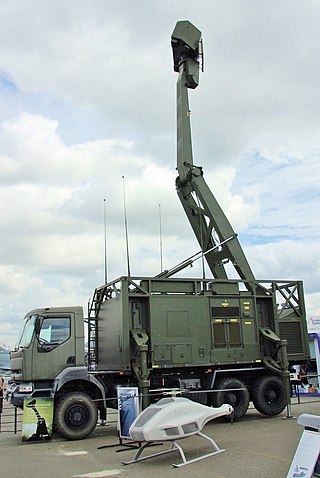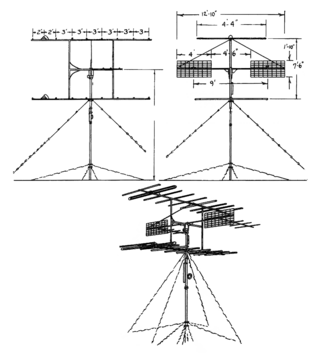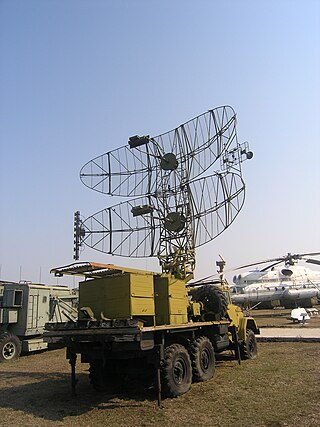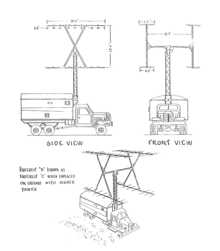
The 9K33 Osa is a highly mobile, low-altitude, short-range tactical surface-to-air missile system developed in the Soviet Union in the 1960s and fielded in 1972. Its export version name is Romb.

A radar picket is a radar-equipped station, ship, submarine, aircraft, or vehicle used to increase the radar detection range around a nation or military force to protect it from surprise attack, typically air attack, or from criminal activities such as smuggling. By definition a radar picket must be some distance removed from the anticipated targets to be capable of providing early warning. Often several detached radar units would be placed in a ring to encircle a target to provide increased cover in all directions; another approach is to position units to form a barrier line.

The Saab Giraffe Radar is a family of land and naval two- or three-dimensional G/H-band passive electronically scanned array radar-based surveillance and air defense command and control systems. It is tailored for operations with medium- and Short Range Air Defense (SHORAD) missile or gun systems, or for use as gap-fillers in a larger air defense system.

The MT-LBu is a Soviet multi-purpose fully amphibious armoured carrier which was developed under the factory index Ob'yekt 10 in the late 1960s, based on the MT-LB. It has a more powerful engine, a 40 cm higher hull and a longer chassis with 7 road wheels on each side.

The "Pegmantit 3" or P-3 was an early VHF radar developed and operated by the former Soviet Union.

The "Pegmantit 8" or P-8 was an early 2D VHF radar developed and operated by the former Soviet Union.

The P-12 "Yenisei" was an early VHF radar developed and operated by the former Soviet Union.

The P-18 or 1RL131Terek is a 2D VHF radar developed and operated by the former Soviet Union.

The P-14 is a 2D VHF radar that was developed and operated by the Soviet Union.

The P-40"Armour" or 1S12 is a 3-D UHF radar developed and operated by the former Soviet Union.

The P-15"Tropa" or 1RL13 is a 2D UHF radar developed and operated by the former Soviet Union.
The P-70 or "Lena-M" was a static 2D VHF radar developed and operated by the former Soviet Union.

The P-19"Danube"1RL134 is a 2D UHF radar developed and operated by the former Soviet Union. The radar was also known by the name "Renata" in Poland and "Dunai" in the former German Democratic Republic.

The P-30"Khrustal", also referred to by the NATO reporting name "Big Mesh" in the west, is a 2D E band/F band radar developed and operated by the former Soviet Union.

The P-20"Periskop", also referred to by the NATO reporting name "Token" in the west, is a 2D E band/F band radar developed and operated by the former Soviet Union.

The P-35, also referred to by the NATO reporting name "Bar Lock" in the west, is a 2D E band/F band radar developed and operated by the former Soviet Union.

Irbis-E is a Russian multi-mode, hybrid passive electronically scanned array radar system developed by Tikhomirov NIIP for the Sukhoi Su-35 multi-purpose fighter aircraft. NIIP developed the Irbis-E radar from the N011M Bars radar system used on Sukhoi Su-30MKI aircraft.

The TRML is a family of air defense radars first developed by Telefunken and currently produced by Hensoldt. It is a development of the earlier TRMS.

The Nizhny Novgorod Research Institute of Radio Engineering (NNIIRT) is a Russian electronics company specializing in the development and manufacturing of radar equipment. It is a subsidiary of the Almaz-Antey group.
This is an overview of Russian early-warning radars for air surveillance, and related design bureaus.


















